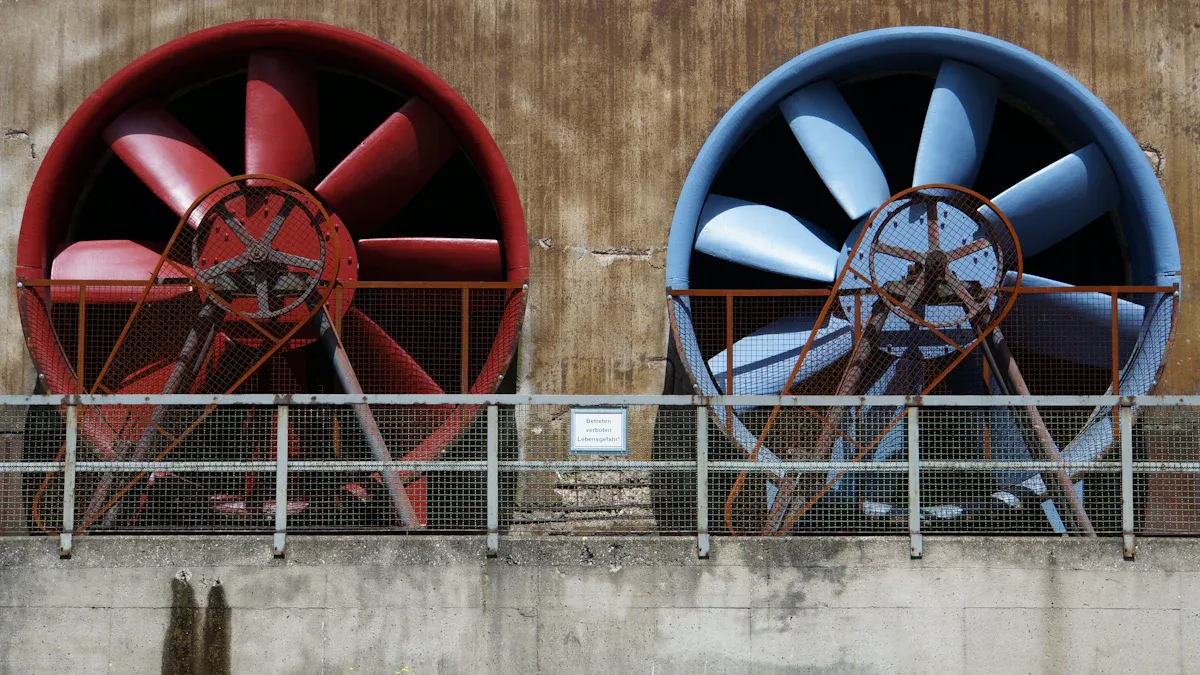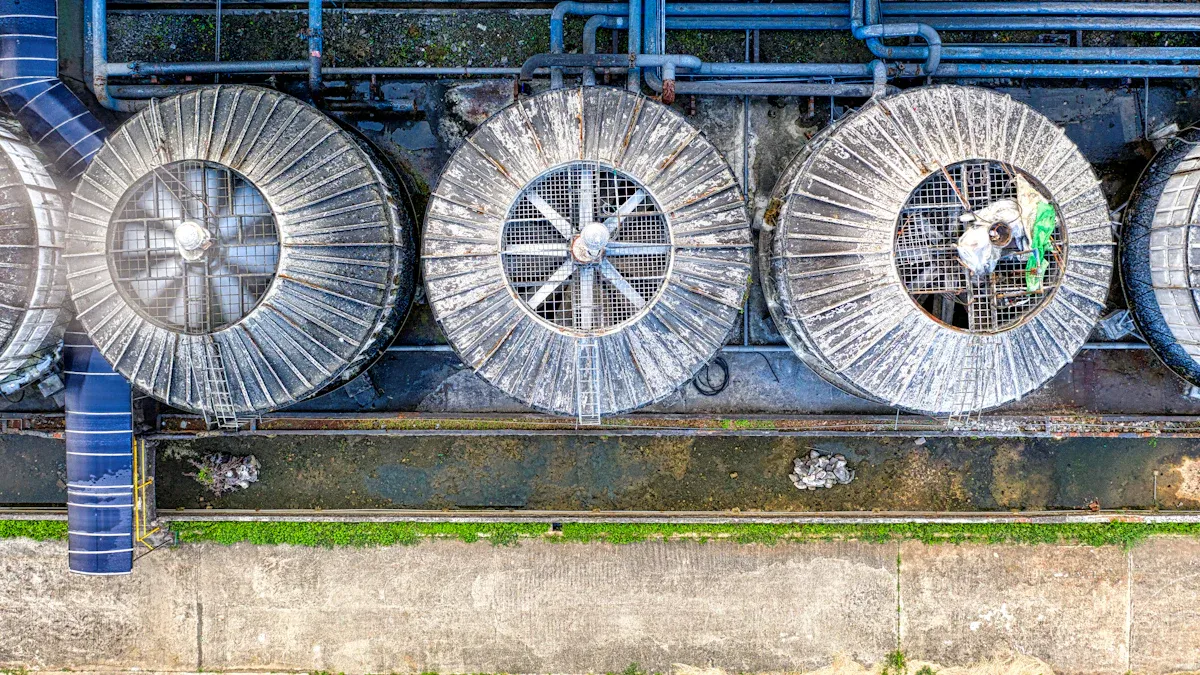
News

A frequency Inverter plays a vital role in optimizing performance in dust removal fans. It adjusts fan speed to ensure optimal airflow, reducing energy consumption significantly. For instance, a fan running at 25% less speed uses only 42% of the power required at full speed. This not only saves energy but also minimizes wear on equipment like dust collector filters. Additionally, frequency converters enhance the automation of dust control systems, ensuring efficient removal of airborne dust particles. With these benefits, you can achieve energy savings of up to 30% while maintaining system reliability.
Key Takeaways
Frequency Inverters adjust fan speed to save up to 30% energy. This lowers costs and makes the system work better.
Variable frequency drives reduce part damage, making systems last longer. They also cut down on repair needs.
Check what your system needs before adding frequency Ionverters. Picking and installing them right helps them work well and stay reliable.
Limitations of Traditional Dust Removal Fans
Energy inefficiency in fixed-speed operations
Traditional dust removal fans often operate at a fixed speed, regardless of the actual airflow demand. This results in significant energy waste, especially during periods of reduced operational requirements. For example, statistical analyses show that running a fan at 25% less speed consumes only 42% of the power needed at full speed. However, fixed-speed fans cannot make such adjustments, leading to excessive energy consumption. In industrial dust collection systems, this inefficiency becomes even more pronounced when airflow needs fluctuate, such as during different stages of steel production. Without the ability to adapt, these fans consume more energy than necessary, driving up operational costs and reducing overall energy efficiency.
Increased wear and tear on components
Fixed-speed dust removal fans also contribute to faster wear and tear on system components. Operating at full speed continuously places unnecessary strain on parts like bearings, motors, and dust collector filters. Over time, this leads to frequent maintenance and higher replacement costs. In industrial dust collection systems, this issue can compromise indoor air quality by reducing the reliability of the dust removal fan. A system that requires constant repairs or replacements disrupts operations and increases downtime, further impacting efficiency.
Inability to adapt to varying operational demands
Another major limitation of traditional dust removal fans is their inability to adjust to changing operational needs. Systems using hydraulic couplers for speed regulation often lack precision and have a limited range of adjustment. This makes it difficult to match airflow to the specific requirements of different processes. For instance, during steel production, the air volume needed can vary significantly. Fixed-speed fans fail to accommodate these changes, resulting in energy waste and reduced system performance. This inability to adapt also affects indoor air quality, as the system may not effectively remove airborne dust particles during peak demand.
Application of Frequency Converters in Dust Removal Systems

Role of variable frequency drives in speed regulation
Variable frequency drives play a crucial role in regulating fan speed within dust collection systems. These drives operate by converting AC current to DC using a diode bridge rectifier. The DC voltage is then smoothed and converted back to AC at the desired frequency through Pulse Width Modulation (PWM). This process, powered by insulated gate bi-junction transistors (IGBTs), allows you to precisely control motor speed.
By integrating variable frequency drives with airflow or static pressure sensors, you can automatically adjust fan speeds to match real-time demands. For example, when airflow requirements decrease, the drive reduces the motor's speed, optimizing energy use. This capability ensures that your system maintains optimal airflow levels, enhancing both efficiency and performance.
"VFDs offer substantial energy savings compared to motor starter relays due to their ability to regulate motor speed according to load demands. The energy reduction is most significant when the motor operates at partial loads, a common scenario in many applications."
Optimizing dust collector energy usage
Using variable frequency drives in dust collection systems significantly reduces energy consumption. At 25% less fan speed, only 42% of full power is consumed, while at 50% less speed, just 12% of full power is used. This translates to an average energy cost reduction of 30%. For instance, a dust collector equipped with a variable frequency drive can save $16,763 annually, with a payback period of under eight months.
Additionally, these drives optimize airflow to prevent premature filter wear, ensuring effective dust collection. By maintaining proper fan speeds, you can maximize filter performance and reduce operational costs. This application not only saves energy but also extends the lifespan of your dust collection system.
Enhancing system reliability and longevity
Frequency converters improve the reliability and longevity of dust collection systems by minimizing mechanical stress. The soft start feature of these drives reduces the impact on motors during startup, extending their lifespan. Furthermore, transitioning to a fully open damper decreases wear and maintenance costs.
In terms of energy savings, the primary dust removal fan can save approximately 611,250 yuan annually, while the secondary fan saves around 500,000 yuan. These savings highlight the long-term benefits of integrating frequency converters into your system. By enhancing system reliability, you can reduce downtime and ensure consistent performance over time.
Practical Steps for Implementing Frequency Converters
Evaluating system requirements and compatibility
Before implementing a variable frequency drive, you need to evaluate your system's requirements and compatibility. Follow these steps:
Motor Compatibility: Confirm that the drive matches the motor type and provides the necessary voltage, current, and control features.
Power Requirements: Ensure the drive's power rating aligns with the motor's power needs, including voltage and current.
Speed Control Range: Identify the required speed control range and accuracy for your application.
Environmental Conditions: Assess the operating environment and select a drive with suitable protection features.
Application-Specific Features: Consider requirements like torque control or communication interfaces.
Compliance and Certification: Verify compliance with industry standards and certifications.
Tip: Use technical documents to compare performance metrics, such as energy savings and static pressure reductions, to ensure compatibility.
Choosing the right variable frequency drive
Selecting the right drive involves understanding your system's needs. Look for:
Compatibility with motor type, voltage, and current ratings.
Features like speed control, torque requirements, and programmability.
Energy efficiency ratings and safety features.
Budget considerations, including installation and maintenance costs.
Using a variable frequency drive can reduce energy costs by 30% on average. For example, operating a fan at 25% less speed consumes only 42% of full-speed power.
Installation and configuration guidelines
Proper installation ensures optimal performance. Follow these best practices:
Installation: Adhere to manufacturer guidelines for wiring, grounding, and mounting.
Commissioning: Configure parameters like motor data, speed control settings, and protection features.
Ventilation: Ensure adequate cooling to prevent overheating.
Protective Devices: Use fuses and circuit breakers to safeguard equipment.
A well-installed drive stabilizes the system, extends equipment life, and reduces maintenance costs.
Maintenance and monitoring for sustained performance
Regular maintenance keeps your system running efficiently. Implement these strategies:
Schedule routine inspections to check for wear or damage.
Use predictive and preventive maintenance systems to anticipate issues.
Monitor real-time data to optimize performance and reduce downtime.
Integrating maintenance tracking solutions enhances reliability and supports long-term operational efficiency.
Calculating Energy and Cost Savings
Factors influencing energy efficiency
Several factors impact the energy efficiency of dust removal systems equipped with frequency converters:
Airflow and energy consumption: Excessive airflow increases energy costs unnecessarily. Maintaining optimal airflow is critical for efficiency.
Filter condition: Dust accumulation on filters raises resistance, requiring more energy to sustain airflow. Regular maintenance ensures better performance.
Automatic speed optimization: Variable frequency drives (VFDs) adjust fan speed based on real-time airflow and pressure data, eliminating the inefficiencies of manual adjustments.
By addressing these factors, you can maximize energy efficiency and reduce operational costs.
Example calculation of energy and cost savings
A documented case study highlights the economic benefits of frequency converters in steelmaking dust removal systems. The primary fan saved 611,250 yuan annually, while the secondary fan saved 500,000 yuan. Together, these savings totaled 1,111,250 yuan per year. The project required an investment of 980,000 yuan, with a payback period of just 1.33 years.
For a smaller-scale example, a dust collector with a 50 HP motor can save $16,763 annually after installing a VFD. This results in a payback period of under eight months. These examples demonstrate how frequency converters deliver substantial savings and quick returns on investment.
Long-term benefits for operational budgets
Integrating frequency converters into your dust removal system provides long-term energy cost savings. On average, VFDs reduce energy costs by 30%. Over time, these savings significantly lower operational expenses, freeing up resources for other priorities. Additionally, reduced wear and tear on components minimizes maintenance costs, further enhancing your budget's efficiency.
Tip: Regularly monitor system performance to sustain these benefits and maximize your return on investment.
Using frequency converters in dust removal fans offers numerous advantages. You can achieve significant energy savings, reduce maintenance needs, and improve system performance.
Tip: Start small by evaluating your current system. Upgrading with variable frequency drives can transform your operations, delivering long-term cost savings and enhanced efficiency. Explore this technology today to unlock its full potential!
FAQ
What is the main purpose of a frequency converter in dust removal fans?
A frequency converter helps you control fan speed. This ensures optimal airflow, reduces energy consumption, and minimizes wear on system components.
How do frequency converters improve system reliability?
They reduce mechanical stress by offering soft start features. This extends motor life and ensures better control over operational demands.
Can frequency converters save energy in all dust removal systems?
Yes, they optimize energy use by adjusting fan speed to match airflow needs. This level of control ensures efficiency across various operational scenarios.
Please give us a message